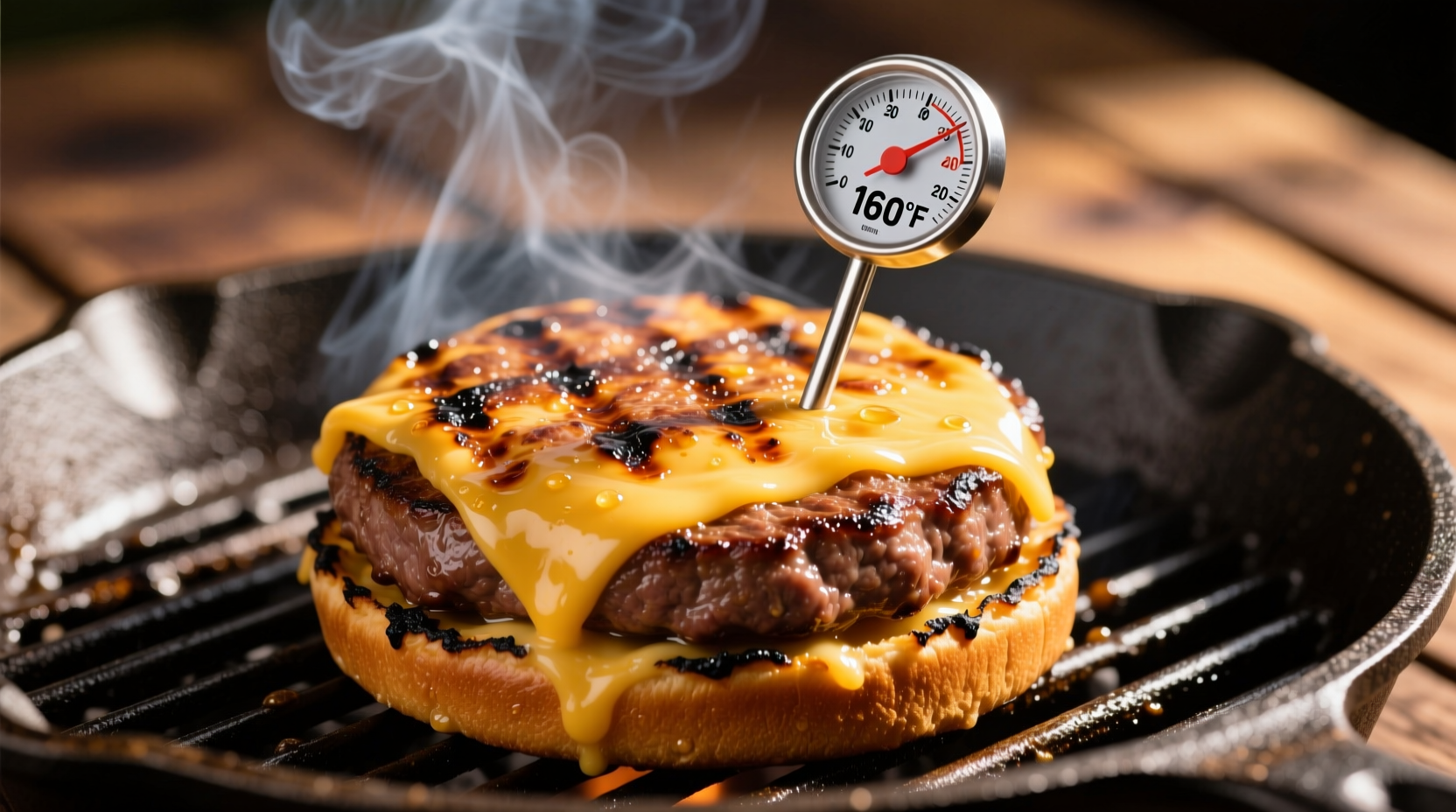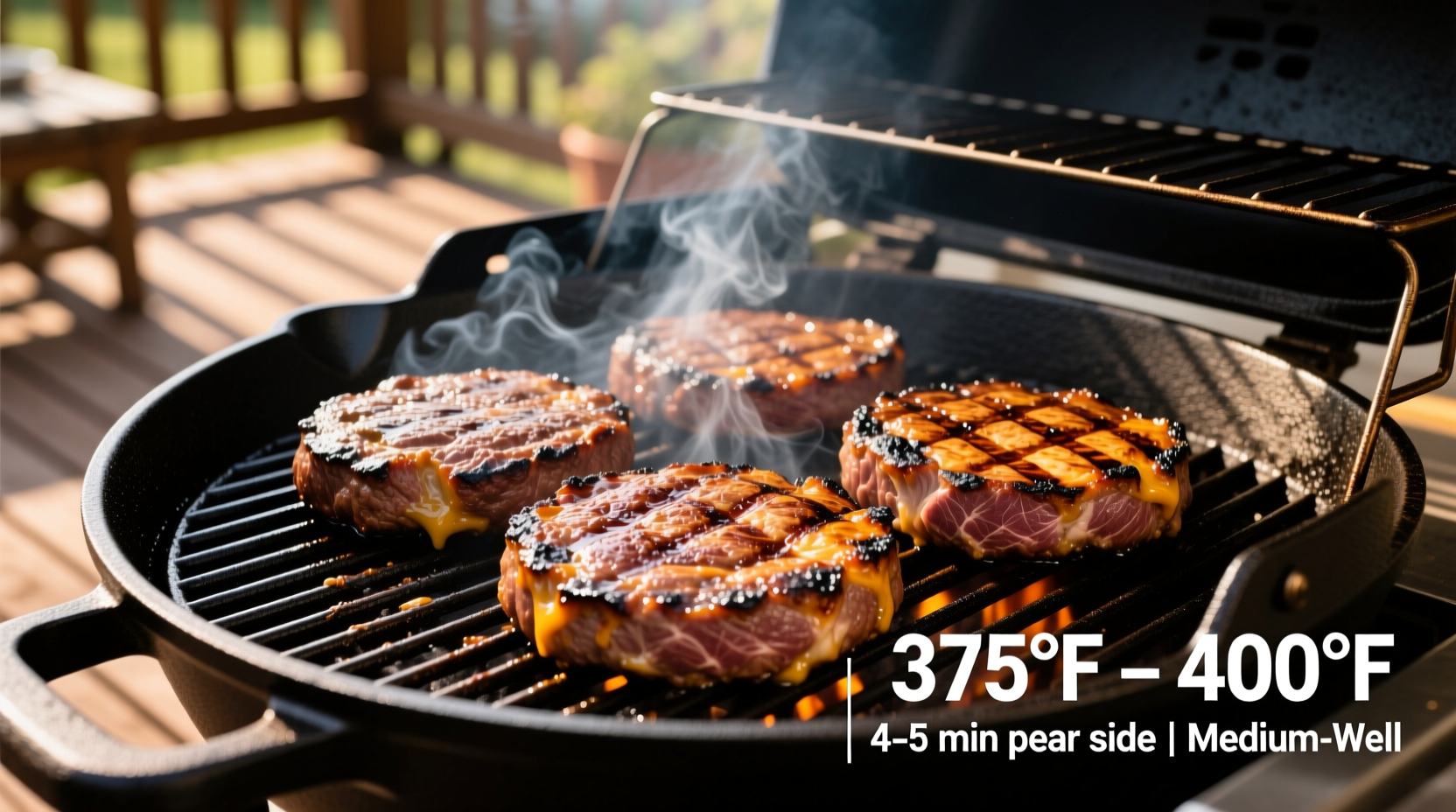The ideal grill surface temperature for cooking burgers is 375°F to 450°F (190°C to 232°C), while the safe internal temperature for fully cooked ground beef burgers is 160°F (71°C) according to USDA food safety guidelines. For optimal juiciness and safety, use a meat thermometer to verify internal temperature rather than relying on cooking time alone.
Grilling the perfect burger isn't just about flipping patties—it's a precise temperature game that transforms ordinary ground beef into juicy, flavorful perfection. Whether you're hosting a backyard barbecue or cooking a quick weeknight dinner, understanding the science behind burger temperatures ensures food safety while maximizing flavor and texture. This guide delivers actionable temperature guidelines backed by culinary science and food safety standards, so you'll never serve a dry, overcooked, or undercooked burger again.
Why Temperature Matters More Than Timing
Timing alone fails as a reliable indicator for burger doneness. Variables like patty thickness, grill type, ambient temperature, and even wind conditions dramatically affect cooking time. The USDA Food Safety and Inspection Service emphasizes that internal temperature is the only reliable method to ensure ground beef reaches a safe minimum internal temperature of 160°F (71°C). Unlike whole cuts of meat, ground beef requires higher temperatures because bacteria from the surface gets distributed throughout during grinding.
| Doneness Level | Internal Temperature | Visual Characteristics |
|---|---|---|
| Rare | 120-125°F (49-52°C) | Very red center, extremely juicy |
| Medium Rare | 130-135°F (54-57°C) | Warm red center, very juicy |
| Medium | 140-145°F (60-63°C) | Pink center, moderately juicy |
| Medium Well | 150-155°F (66-68°C) | Slightly pink center, less juicy |
| Well Done | 160°F+ (71°C+) | No pink, minimal juice |
Note: The USDA recommends cooking ground beef to 160°F for safety, but many chefs pull burgers at 150-155°F for medium-well and allow carryover cooking to reach the safe temperature during resting.
Setting Up Your Grill for Success
Proper grill temperature management creates the ideal environment for perfect burgers. Follow these steps for consistent results:
Two-Zone Fire Setup (Essential for Control)
- Direct heat zone: 375-450°F (190-232°C) for searing and grill marks
- Indirect heat zone: 250-300°F (121-149°C) for finishing without burning
For gas grills, preheat with all burners on high for 10-15 minutes, then adjust to create your two zones. For charcoal, arrange coals to one side for direct heat and leave the other side empty for indirect cooking. Always clean the grates thoroughly before cooking to prevent sticking and ensure clean sear marks.
The Perfect Burger Cooking Process
Follow this temperature-focused method for consistently excellent results:
Step 1: Prepare Your Patties
- Form 3/4-inch thick patties slightly wider than your bun (they'll shrink)
- Create a shallow dimple in the center to prevent bulging
- Season generously with salt and pepper just before grilling
Step 2: Grill Temperature Management
Place patties on the direct heat zone. For a standard 1/4-pound patty:
- Rare: 2-3 minutes per side (pull at 120°F)
- Medium Rare: 3-4 minutes per side (pull at 130°F)
- Medium: 4-5 minutes per side (pull at 140°F)
- Medium Well: 5-6 minutes per side (pull at 150°F)
- Well Done: 6-7 minutes per side (pull at 160°F)
Flip only once when you see liquid pooling on the surface—never press down with a spatula, as this squeezes out precious juices. If flare-ups occur, move patties temporarily to the indirect zone.
Step 3: The Critical Resting Phase
After removing burgers from the grill, let them rest for 5 minutes. During this time, carryover cooking will raise the internal temperature by 5-10°F while allowing juices to redistribute. This is why professional chefs typically remove burgers 5°F below the target temperature.

Temperature Troubleshooting Guide
Encountering issues with your burger temperatures? Here's how to fix common problems:
Burger Too Dry
Cause: Overcooking beyond 160°F or pressing patties during cooking
Solution: Use a thermometer and remove at 155°F for medium-well, allowing carryover cooking to reach 160°F during resting.
Burger Still Pink Inside
Cause: Inconsistent patty thickness or inaccurate thermometer
Solution: Check multiple spots with your thermometer—ground beef can appear pink even when properly cooked due to myoglobin reactions, but always verify with a thermometer.
Exterior Burns Before Interior Cooks
Cause: Grill too hot or patties too thin
Solution: Start on direct heat for searing (2-3 minutes), then move to indirect zone to finish cooking without burning.
Special Considerations for Different Burger Types
Not all burgers follow the same temperature rules. Adjust your approach based on these variables:
Thicker Gourmet Burgers (6-8 oz)
These require lower grill temperatures (350-400°F) and longer cooking times. Sear both sides on high heat, then finish over indirect heat, checking temperature frequently.
Turkey or Chicken Burgers
Poultry requires higher internal temperatures for safety—165°F (74°C). Use a slightly cooler grill (350°F) to prevent drying out these leaner proteins.
Veggie Burgers
Most store-bought veggie burgers only need heating through to 165°F. Grill at medium heat (350°F) to prevent crumbling, and flip carefully.
Essential Tools for Temperature Precision
Invest in these tools to master burger temperatures:
- Digital instant-read thermometer: Provides accurate readings in 3-5 seconds (Thermoworks Mk4 is industry standard)
- Leave-in probe thermometer: For monitoring temperature without opening the grill
- Grill surface thermometer: Ensures proper preheating and consistent cooking surface
- Heat-resistant gloves: For safe handling when checking temperatures
Regularly calibrate your thermometer by testing in ice water (should read 32°F/0°C) or boiling water (212°F/100°C at sea level) to maintain accuracy.
Food Safety Reminders
According to the USDA Food Safety and Inspection Service, ground beef must reach 160°F internally to destroy harmful bacteria like E. coli and Salmonella. Never partially cook burgers and finish later, as this creates a dangerous temperature zone where bacteria multiply rapidly. Always clean thermometers between uses with hot, soapy water to prevent cross-contamination.
Mastering Temperature Variables
Several environmental factors affect burger cooking temperatures:
- Altitude: At higher elevations, water boils at lower temperatures, requiring slightly longer cooking times
- Meat temperature: Cold patties from the refrigerator need 1-2 minutes longer than room-temperature patties
- Grill lid: Keeping the lid closed maintains consistent temperature and reduces cooking time by 20-30%
- Wind: Breezy conditions can lower grill temperature by 25-50°F
For consistent results, always start with room-temperature patties and monitor actual grill temperature rather than relying on dial settings.











 浙公网安备
33010002000092号
浙公网安备
33010002000092号 浙B2-20120091-4
浙B2-20120091-4